In casting about for some basic piano options (just something I hadn’t done before), I thought I’d dig into the MDA Piano option bundled with MG3. The sound seems perfectly suitable, but for whatever reason it seems like I just get a remarkable number of false/unplayed notes with it, that I don’t get in, say, Decent Sampler’s Basic Piano, or with piano samples in IK’s SampleTank.
In my MG3 patch (I’m currently testing in iOS JTBC), I’ve tried changing the tracker itself, between “MG3 Expressive” and “MG2 No Bends” and with the Gate at various levels, and I’ve tried playing with the options in the MIDI Out module too, but I haven’t yet found a combination that doesn’t give me unplayed notes in between the real ones.
Of course my first thought was, “Is it my playing?” but I don’t think that’s it. I don’t get any such issues for example with the SWAM woodwinds, even with everything set up to be gloriously, fantastically touch-sensitive. (This concept “there is MPE right there in your fingers” is absolutely mind-blowing, and the moreso the closer I get to it.)
And the direct contrast somehow seems telling. The aforementioned Decent Sampler and SampleTank pianos both seem happy with the tracker set at “MG3 Expressive” and with the gate set around 20-25, and with the MIDI Out module set at “MIDI 1.0 Multichannel” with channel pressure and no bends. I get a few false notes every now and then, but nothing that actually seems out of whack (with a little attention, I can nearly always “play around them” with careful muting). The MDA Piano, though, although it sounds good, just seems to throw a whole lot more falsies, no matter how I configure things.
Do others see false notes with MDA Piano?
As I write this (and of course I’m away from my gear as I write this), I realize I haven’t tried decoupling my Modulators to see if that has an effect. Lately I have been using Modulators to “expand” the sensitivity of Strike and Pressure on almost everything I use (“expand” meaning I use the Modulators’ handles to set a truly maximum range on both, and then map this directly into the MIDI Out module) as well. This change is like magic in the SWAM instruments, but might it have an effect here? I wouldn’t think so, but clearly something’s different here.
Anyway, any wisdom here would be much appreciated!
